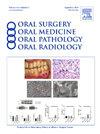Oral condyloma acuminatum: a clinicopathologic study of 25 cases
IF 1.9
3区 医学
Q2 DENTISTRY, ORAL SURGERY & MEDICINE
Oral Surgery Oral Medicine Oral Pathology Oral Radiology
Pub Date : 2025-07-21
DOI:10.1016/j.oooo.2025.04.069
引用次数: 0
Abstract
Introduction
Condyloma acuminatum (CondA) is a benign proliferative lesion of the squamous epithelium caused by the human papillomavirus (HPV), most often HPV-6 and -11. It presents as single or multiple papular or papillary lesions commonly found on anogenital skin and mucosa. CondA of the oral cavity was reported to mostly occur in sexually active men in the third and fourth decades. The objective of this study is to characterize the clinical and histopathologic features of a series of oral CondA.
Materials and Methods
Cases were identified from the archives of StrataDx Inc. from March 2020 to September 2022. Clinical data and histopathologic features were evaluated.
Results
There were 25 biopsies from 24 patients with 19 males (79.2%) and M:F of 3.8:1. The median age was 59 years (range 27-84 years); 76.0% of patients were 50 years or older. The most frequently affected site was the lower lip mucosa (28.0%); the ventral tongue, dorsal tongue, floor of mouth, and palatal mucosa were involved in 12.0% of cases each. CondA showed subtle or obvious papillary squamous epithelial hyperplasia with mild parakeratosis and bulbous rete ridges, arising from a sessile base. All cases exhibited cytologic atypia and intra-epithelial and stromal inflammation were noted in 32.0% and 52.0% of cases respectively. Apoptotic cells, karyorrhectic cells, and koilocytes were present in all cases and the mitotic count varied from 1 to 18 mitoses/10 high-power fields (median = 9 mitoses). All cases tested positive for HPV-6 and -11 by in situ hybridization.
Conclusions
Oral CondA mostly occurred in males generally in the sixth decade and older. It should be distinguished from other histologic mimics, including squamous papilloma but especially bluntly invasive squamous cell carcinoma and verrucous carcinoma because epithelial hyperplasia may be marked and there is generally significant cytologic atypia.
口腔尖锐湿疣25例临床病理分析
尖锐湿疣(CondA)是一种由人乳头瘤病毒(HPV)引起的鳞状上皮的良性增生性病变,最常见的是HPV-6和-11。它表现为单个或多个丘疹或乳头状病变,常见于肛门生殖器皮肤和粘膜。据报道,口腔的CondA主要发生在性活跃的男性在第三和第四十年。本研究的目的是描述一系列口腔CondA的临床和组织病理学特征。材料和方法病例来源于StrataDx公司2020年3月至2022年9月的档案。评估临床资料和组织病理学特征。结果24例患者活检25例,男性19例(79.2%),M:F为3.8:1。中位年龄59岁(范围27-84岁);76.0%的患者年龄在50岁及以上。最常见的受累部位为下唇黏膜(28.0%);舌腹、舌背、口底和腭黏膜各占12.0%。CondA显示轻微或明显的乳头状鳞状上皮增生,伴轻度角化不全和球根状网状隆起,起源于无柄基部。所有病例均表现为细胞学异型性,上皮内和间质炎症分别占32.0%和52.0%。所有病例均存在凋亡细胞、核致密细胞和角质细胞,有丝分裂计数从1到18个有丝分裂/10个高倍视场(中位数 = 9个有丝分裂)。所有病例经原位杂交检测HPV-6和-11阳性。结论口腔CondA多见于男性,年龄一般在60岁及以上。它应该与其他组织学上的类似物区分开来,包括鳞状乳头状瘤,尤其是浸润性鳞状细胞癌和疣状癌,因为上皮增生可能很明显,通常有明显的细胞学异型性。
本文章由计算机程序翻译,如有差异,请以英文原文为准。
求助全文
约1分钟内获得全文
求助全文
来源期刊

Oral Surgery Oral Medicine Oral Pathology Oral Radiology
DENTISTRY, ORAL SURGERY & MEDICINE-
CiteScore
3.80
自引率
6.90%
发文量
1217
审稿时长
2-4 weeks
期刊介绍:
Oral Surgery, Oral Medicine, Oral Pathology and Oral Radiology is required reading for anyone in the fields of oral surgery, oral medicine, oral pathology, oral radiology or advanced general practice dentistry. It is the only major dental journal that provides a practical and complete overview of the medical and surgical techniques of dental practice in four areas. Topics covered include such current issues as dental implants, treatment of HIV-infected patients, and evaluation and treatment of TMJ disorders. The official publication for nine societies, the Journal is recommended for initial purchase in the Brandon Hill study, Selected List of Books and Journals for the Small Medical Library.
 求助内容:
求助内容: 应助结果提醒方式:
应助结果提醒方式:


